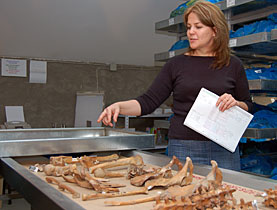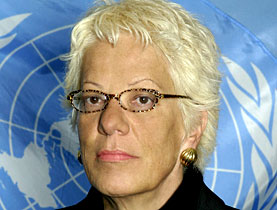Solving the “forensic puzzle” of Srebrenica

As the genocide trial of former Bosnian Serb leader Radovan Karadzic gets underway in The Hague, the grizzly task of identifying victims continues.
The Swiss-backed International Commission on Missing Persons (ICMP) is using DNA to help survivors track down their murdered relatives to be able to give them a dignified burial.
Three thousand plastic bags line metre-high shelves in an ICMP mortuary in the north Bosnian town of Tuzla.
Every sack contains bones or bone fragments – all that remains of victims of the genocide against Muslims in Srebrenica in 1995, Europe’s worst massacre since the Second World War.
Bosnian Serb forces, commanded by General Ratko Mladic, killed about 8,000 Bosnian Muslim men and boys after the eastern town, which was a United Nations-protected safe zone, fell into their hands.
Most were killed while trying to escape through woods, either shot or arrested and taken to places of execution before being buried in mass graves.
The International Criminal Tribunal for the Former Yugoslavia in The Hague has sentenced seven Bosnian Serbs for the Srebrenica massacre. Nine more are on trial. Mladic is still on the run, 14 years after he was indicted.
Karadzic, who has boycotted his trial since it started last week, arguing that he needs more time to prepare his defence, will appear in court on Tuesday, two of his legal advisers said on Monday.
DNA
Fourteen years on, the people of Srebrenica have yet to come to terms with the trauma. Thousands still don’t know what happened to family members. Now they want to find the remains, so they can at least be buried with dignity. For this, all their hopes lay with the ICMP.
The commission, to which Switzerland has contributed around SFr900,000 ($880,000), has given itself the task of identifying the bones of everyone who went missing in the former Yugoslavia.
To that end, the ICMP focuses on comparing DNA from exhumed bones with that from the blood of relatives.
“If there is a 99.95 per cent match, the remains count as identified,” said the ICMP’s Pakica Colo.
Around 40,000 people were classed as missing after the war in the former Yugoslavia, some 30,000 of them in Bosnia and Herzegovina alone.
Since 2001, the ICMP has developed a database of 87,500 relatives of almost 29,000 missing people. By matching DNA from blood and bone samples, it has been able to identify the remains of more than 15,000 people. The majority – 12,600 – died during the war in Bosnia and Herzegovina and almost half in the genocide in Srebrenica.
Mass graves
Srebrenica is the “case” in which the ICMP is currently most involved. This is not only because of the large number of deaths, but also because some bodies were repeatedly dug up and reburied elsewhere.
“When satellite pictures of the mass graves appeared a few months after the massacre, those responsible wanted to cover their tracks,” said Jasmina Mameledzija from the ICMP.
“They would come at night, when the earth was damp, and use heavy machinery to load the corpses onto lorries. Many bodies were ripped apart.”
This explains how a person’s skull could be found in one grave, their thigh bone in another and their ribcage in a third.
In addition thousands of bones were crushed by bulldozers and excavators.
“One man’s skeleton was put together by bones found in four different graves,” she said. “Often our work is like a massive forensic puzzle.”
Dignified burial
Anthropologists at the Lukavac Reassociation Centre near Tuzla are busy trying to solve these countless “puzzles”.
On large metal tables the experts try, in meticulous detail, to piece together skeletons.
“We can’t carry out a DNA analysis for every bone,” explained Cheryl Katzmarzyk, head forensic anthropologist. “We order the bones by age, abrasion or distinguishing marks.”
It is rare to exhume a complete skeleton of a victim of Srebrenica.
“We’re happy to get just one bone,” said Nura Begovic, a member of the “Women of Srebrenica” victim group who lost her father, only brother, father-in-law and more than a dozen other relations.
“It is so important to be able to bury our loved ones, to have a gravestone which we can visit,” she said.
Begovic has so far been able to bury six relatives. No trace has yet been found of the others.
Norbert Rütsche in Tuzla, swissinfo.ch (Adapted from German by Thomas Stephens)
The war in Bosnia-Herzegovina raged from 1992 to 1995. It took the lives of about 100,000 people.
After the break-up of the republic of Yugoslavia, large parts of the Serb population of Bosnia and Herzegovina wanted closer ties to Serbia, many Croats wanted the same to Croatia and Bosnians wanted their own state.
Tensions escalated in March 1992 after the independence of the republic of Bosnia and Herzegovina and the proclamation of a Bosnian-Serb republic were declared.
So-called ethnic cleansing ended in armed conflict among all three large ethnic groups.
The Bosnian Serbs, strongly supported militarily by the Serbia of Slobodan Milosevic, soon controlled 70% of the territory of Bosnia and Herzegovina.
International mediation efforts and the deployment of United Nations troops could not contain the war for a long time.
After the Serbian side was forced on the defensive in 1995, the warring parties held negotiations that brought about the Dayton Agreement, putting an end to the conflict.
Under the terms of the agreement Bosnia and Herzegovina, Croatia and the Federal Republic of Yugoslavia agreed to fully respect the sovereign equality of one another and to settle disputes by peaceful means.
The International Commission on Missing Persons (ICMP) was established at the initiative of US President Bill Clinton in 1996.
Its primary role is to ensure the cooperation of governments in locating and identifying those who have disappeared during armed conflict or as a result of human rights violations. It is currently headquartered in Sarajevo.
After the Asian tsunami in December 2004, the ICMP played a leading role in efforts to identify thousands of victims in Thailand and the Maldives. It also helped identify the victims of Hurricane Katrina in the United States. The ICMP is currently assisting the government of Iraq in addressing the issue of decades of large-scale disappearances and has assisted Kuwait in identifying victims of Iraq’s 1990’s occupation. The ICMP is also part of a government-sponsored initiative in Chile aimed at establishing a legal and technical process to identify the remains of people who went missing during the Pinochet regime.

In compliance with the JTI standards
More: SWI swissinfo.ch certified by the Journalism Trust Initiative













You can find an overview of ongoing debates with our journalists here . Please join us!
If you want to start a conversation about a topic raised in this article or want to report factual errors, email us at english@swissinfo.ch.